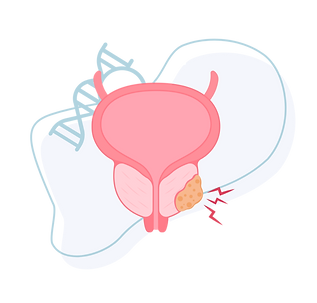Description:
If a mutation is identified in a known prostate cancer risk gene, it indicates an increased risk compared to the general population. However, it doesn't guarantee you will develop cancer. The specific gene mutated and your family history can influence the risk level. In the same way, if no mutations are found this does not guarantee that you will not develop prostate cancer from other risk factors or unknown genetic variations.
Gene List:
ATM (Ataxia Telangiectasia Mutated): This gene plays a critical role in the DNA damage response pathway. When DNA damage occurs, ATM helps to activate cell cycle arrest and DNA repair mechanisms. Mutations in ATM can cause ataxia-telangiectasia, a rare genetic disorder characterized by progressive neurological problems, immune deficiencies, and an increased risk of cancer.
BRCA1 (Breast Cancer Gene 1): This well-known tumour suppressor gene plays a critical role in DNA repair. Mutations in BRCA1 significantly increase the risk of breast cancer, ovarian cancer, and some other cancers.
BRCA2 (Breast Cancer Gene 2): Similar to BRCA1, BRCA2 is another tumour suppressor gene involved in DNA repair. Mutations in BRCA2 also significantly increase the risk of breast cancer and ovarian cancer, as well as other cancers.
CHEK2 (Checkpoint Kinase 2): This gene plays a role in DNA damage response and cell cycle arrest. CHEK2 helps to activate repair mechanisms when DNA damage occurs and can also trigger cell death if the damage is too severe. Mutations in CHEK2 can increase the risk of various cancers, including breast cancer and colon cancer.
EPCAM (Epithelial Cell Adhesion Molecule): This gene encodes a protein present on the surface of epithelial cells. EPCAM is not directly involved in cancer development but is a commonly used marker for identifying and isolating epithelial cancer cells in diagnostic tests.
MSH6, MLH1 & MSH2: These genes are all involved in DNA mismatch repair (MMR), a critical process for correcting errors that occur during DNA replication. Mutations in any of these genes can impair MMR, leading to increased mutations and a higher risk of developing certain cancers
NBN (Nibrin): This gene encodes a protein involved in the DNA damage response pathway. NBN helps to activate cell cycle arrest and DNA repair mechanisms when DNA damage occurs. Mutations in NBN can disrupt this response, leading to increased genomic instability and a higher risk of developing cancers, such as breast cancer and leukaemia.
PALB2 (Partner and Localizer of BRCA2): This gene encodes a protein that interacts with BRCA2, a well-known tumour suppressor gene involved in DNA repair. PALB2 helps BRCA2 function correctly in DNA repair processes. Mutations in PALB2 can increase the risk of breast cancer and other cancers like BRCA2 mutations but with a generally lower penetrance (likelihood of developing cancer).
PMS2: This gene checks for errors in cell division and works with other proteins to repair them. Sometimes, mistakes (mutations) can occur in the PMS2 gene. These variations can weaken the PMS2 protein or prevent it from working correctly. This can lead to uncorrected errors in the DNA blueprints, which over time might increase the risk of certain cancers, particularly colorectal cancer (cancer of the colon and rectum) and endometrial cancer (cancer of the lining of the uterus). This is known as Lynch syndrome
RAD51D: This gene plays a vital role in a process called DNA double-strand repair, a process that fixes severe breaks in DNA Blueprints, which are essential for maintaining healthy cells. Mutations in the RAD51D gene can affect its ability to function correctly. This can hinder the cell's ability to repair DNA double-strand breaks effectively. Over time, this might increase the risk of developing certain cancers, particularly breast cancer, ovarian cancer, and pancreatic cancer.
HOXB13: The two main roles of this gene are skin development and maintenance and potential tumour suppressor. sometimes, changes (mutations) can occur in the HOXB13 gene. These variations might: Affect its role in skin development, potentially leading to skin conditions (although this is less well-understood). Impair its tumour suppressor function, potentially increasing the risk of certain cancers, particularly prostate cancer.
TP53 (Tumour Protein 53): This well-known tumour suppressor gene encodes a protein called p53, often referred to as the "guardian of the genome" due to its critical role in DNA repair, cell cycle arrest, and apoptosis (programmed cell death). Mutations in TP53 are the most common genetic alterations found in human cancers and can contribute to various types of cancer. TP53 mutations or loss of p53 function is a biomarker used in cancer diagnosis and prognosis.
Estimated Turnaround times:
6 Weeks
Note:
This service is only available to the age of 13 and above.
During booking, only a £30 deposit is required, which will be deducted from the total cost. The remaining payment will be collected at a later stage.
Any cancellation, rescheduling, or missed appointment within 48 hours of the scheduled time will result in the loss of the £30 deposit. If you wish to reschedule, a new £30 deposit will be required to secure the new appointment.
.png)
